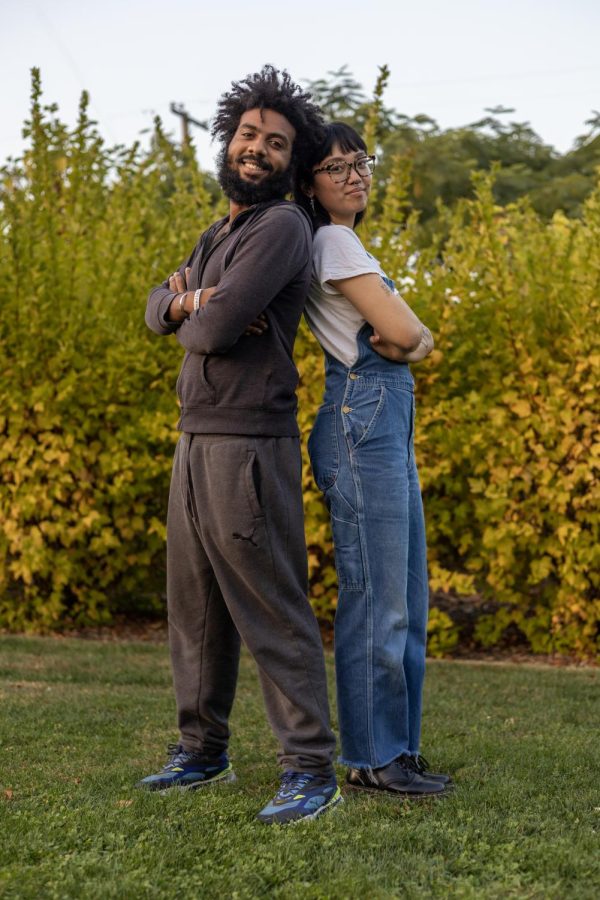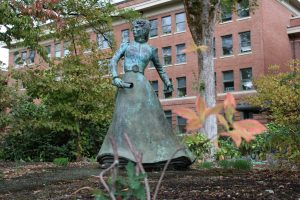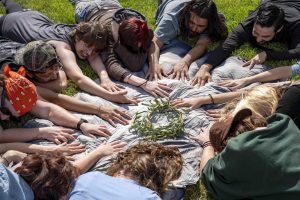SOL: Brightening campus from within the Pride Center
Two SOL volunteers posed outside of the Student Experience Center.
November 3, 2022
For the past 18 years, SOL: LGBTQ+ Multicultural Support Network, which translates to sun, has been brightening our campus by offering a safe place and familial atmosphere for queer and trans people of color.
SOL: Sun
While people may believe SOL is an acronym, that is not the case. According to the SOL website, the name is a metaphor. In languages like Spanish and Portuguese, the word SOL translates to sun.
“Moreover, the sun’s rays are used to make a prominent symbol of the LGBTQ+ community: the rainbow. Like the sun, SOL: LGBTQ+ Multicultural Support Network is intended to brighten our campus by improving its climate,” the website stated.
SOL beginnings
The idea for SOL was first brought up in 2002 by graduate student Derron Coles, a gay Black student who transferred from the University of Maryland, Baltimore County to Oregon State University for his Master’s and Ph.D. studies.
In a 2019 interview found in OSU’s Special Collections & Archived Resource Center, Coles said that for most of his life, he had always felt the effects of his sexual orientation, but upon his arrival at OSU, as one of the only Black men in most of his classes, he felt the effects of both his sexual orientation and race.
At OSU, Coles said he had just started coming out to people. He felt comfortable enough because the college offered him a community through the Queer Resource Center. He came out expecting that he would be welcomed and included among individuals like himself.
However, Coles said he began to experience unexpected microaggressions within the gay community, even when trying to participate in Pride Week, all leading up to an incident where he was called a racial slur by a gay white man whom he had considered a friend.
It was at that point he knew that things had to change and he had to do something to protect future students from going through what he did.
In 2004, Coles was able to get SOL recognized as an official student organization at OSU, but he still needed funding. In 2006, he brought his proposal to Larry Roper, a now-retired OSU professor, who at the time was the vice provost for Student Affairs. In an interview with Dr. Roper, he stated that he immediately agreed and began funding the organization because he understood there was a unique need to have a place within the Pride Center that represented the QTPOC community and promoted diversity and inclusivity.
SOL 20 years later
It’s been nearly 20 years since then, and SOL has grown substantially as LGBTQ+ Multicultural Support Network within the Pride Center.
Although SOL is hosted in the Pride Center, students can find SOL liaisons in each of the seven Cultural Centers.
Julian Clarke, a leadership liaison for SOL, said there are many ways students can connect within the LGBTQ+ Support Network.
SOL serves as a bridge between queer spaces and other cultural centers, so anyone wanting to inquire about SOL or the Pride Center can do so through any one of these liaisons.
Clarke said a person walking into SOL will find that it has a laid-back and familial atmosphere and is a very diverse space with people of different backgrounds and identities.
Upon visiting SOL at the Pride Center, a student will find friendly workspaces, a library area, a sensory section in the corner and a space to hang out and play some Mario-Kart. There is also a Really Free Closet that offers anything from books to clothing.
If a student is hesitant to come in person, SOL has a huge online presence through their Facebook and Instagram, as well as a Podcast called “Between Identities” and a newsletter in the works that will keep students up to date on all SOL activities. There are also opportunities to attend regular events organized by or done in collaboration with SOL.
What SOL stands for
“There is a lot of adversity within racial minorities because of historical impressions,” Clarke said. “They’ve been implemented on us because of colonialism. Black people may not feel comfortable being queer because of the violence that happens in our communities frequently through police violence or through violence with misogyny and transphobia and homophobia. Different communities may feel like they might be outcasted if people find out.”
Clarke said SOL will frequently see situations where a student from a minority background, who comes to OSU with friends and family back home rooting for their success, is afraid that they will lose everything if they are outed or caught in the Pride Center.
To those people, Clarke stressed that SOL is here for them. Their goal is to make sure each student feels completely safe, and that they have a safe place to explore their different identities with others who are exploring theirs as well.






